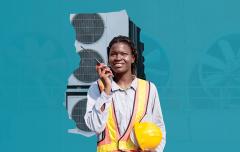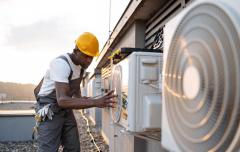Can China keep the climate cool while its air-conditioning market heats up?
Alan Miller, a former climate change policy specialist at the World Bank, is co-author of Chilling Prospects: Providing Sustainable Cooling for All, which was recently issued by the UN-affiliated Sustainable Energy for All
Among the many impressive achievements of China’s rapid economic growth has been providing electricity to nearly all of its population, which has improved living standards in many ways. But one unintended consequence of this success has been the extensive use of air conditioning, which poses a potential risk to the global environment in the form of greenhouse gas emissions and climate change.
In 1990, few Chinese households had an air conditioner. Now the average is one per household. China has become the global leader in producing and using air conditioners, responsible for making 70 per cent of units worldwide and accounting for 35 per cent of global stock, compared with 23 per cent in the United States.
Although air conditioners increase economic productivity, they are also the source of environmental damage. Many are energy inefficient, consuming more power still largely provided by coal, which produces carbon dioxide, the largest source of global warming. They also rely on the use of hydrofluorocarbons (HFCs) as refrigerants, which have high global warming potential when released into the atmosphere.
As China’s economy continues to grow, so will the purchase and use of air conditioners. A big potential market is the nearly 200 million low-income urban dwellers in China who are subject to worsening heat extremes, but have limited access to cooling systems. This large group needs to be helped without further adding to the climate threat.
Demand for air conditioners is particularly strong in south China, which suffers from more tropical heat than the north. According to a recent Massachusetts Institute of Technology study, China’s northern plain is also set to become one of the world’s deadliest heatwave zones in the future.
Chinese Premier Li Keqiang waves as he and European Commission President Jean-Claude Juncker (left) and European Council President Donald Tusk (second from left) leave a press conference at the end of an EU-China summit at the European Council in Brussels in June 2017. The EU and China agreed to increase cooperation to fight climate change after President Donald Trump pulled the US out of the Paris climate deal last summer. Photo: AFP
The International Energy Agency forecasts that 1 billion air conditioners will be installed globally over the next decade, increasing world stock by two-thirds, with China remaining a key player. If air conditioners do not become more energy efficient, then hundreds more power plants will be needed. Greenhouse gas emissions will increase dramatically and threaten prospects for achieving the goal set by the Paris Climate Agreement – to limit the rise in global temperatures to less than 2 degrees Celsius from pre-industrial levels.
China, as the largest emitter of greenhouse gases in the world, has a special responsibility in addressing this issue. Fortunately, it is asserting leadership on climate change internationally. Under government leadership, it is implementing an ambitious combination of climate policies, including a carbon trading programme, while leading the world in the production and use of solar and wind power. It is on track to exceed its emission reduction goals.
But ways of dealing with the environmental problems posed by air conditioning should form an integral part of such plans. This should include development of a national cooling plan integrated into China’s long-term energy and greenhouse gas emissions strategy, while making cooling efficiency a priority.
Another good place to start is with the low-carbon pilot projects being introduced in more than 80 Chinese cities and six provinces. These localities are emerging as climate action leaders, committed to curbing carbon emission peaks ahead of the national government’s 2030 deadline.
The tools to help accelerate low-carbon initiatives and create the conditions for sustainable cooling access could include district cooling and thermal energy storage, providing residences with thermal cooling systems, introducing central cooling centers for the public and promoting heat action plans when high temperatures pose a risk to health.
It is also estimated that China needs to invest more than US$250 billion to support the construction of cost-effective and energy-efficient green buildings and retrofit existing ones within the next decade. This effort should include taking the harmful effects of air conditioning into account and providing alternative passive cooling options or promoting the use of more energy-efficient air conditioners.
Related to this initiative is the need to develop financial structures in China to provide capital for energy-efficiency technology and help the construction of green buildings so China can reach its low-carbon goals. In the meantime, China can resort to more low-tech measures such as painting roofs and walls white, or in other light colours, to help reflect sunlight and make interiors cooler.
As one of the world’s biggest producers of air conditioners, many of which are exported to developing countries, China also has a responsibility to promote the manufacture of hyper-efficient air conditioners. This would help create a potential huge market for Chinese appliance makers.
The government should support such efforts through the adoption of more stringent energy performance standards and efficiency labelling. Financing schemes for consumers should be more closely tied to the best energy-efficient units available.
Another important step would be for China to ratify the 2016 Kigali Amendment to the 1987 Montreal Protocol to protect the ozone. The amendment aims to cut the production and consumption of HFCs with high global warming potential by more than 80 per cent over the next 30 years and replace them with environmentally friendly alternatives. Ratification would help spur China to provide financing for the simultaneous replacement of HFCs and improve the energy efficiency of cooling systems.
China can show the way in making the world a cooler place despite global warming.
This article first appeared in the South China Morning Post print edition as: China needs to cool its market for air conditioners. The online version can be found here





